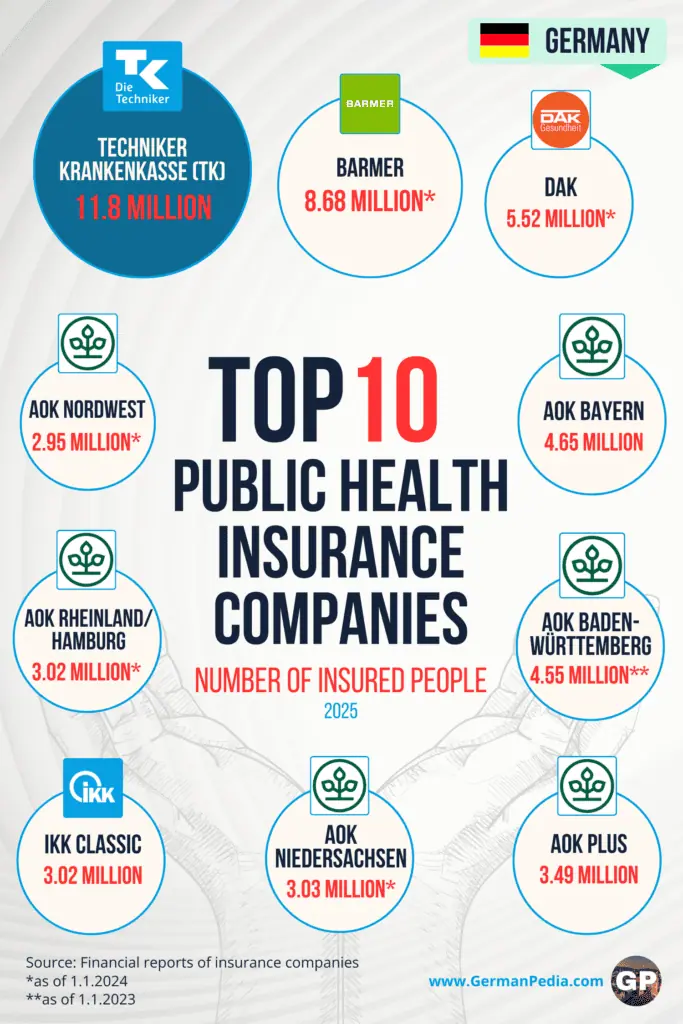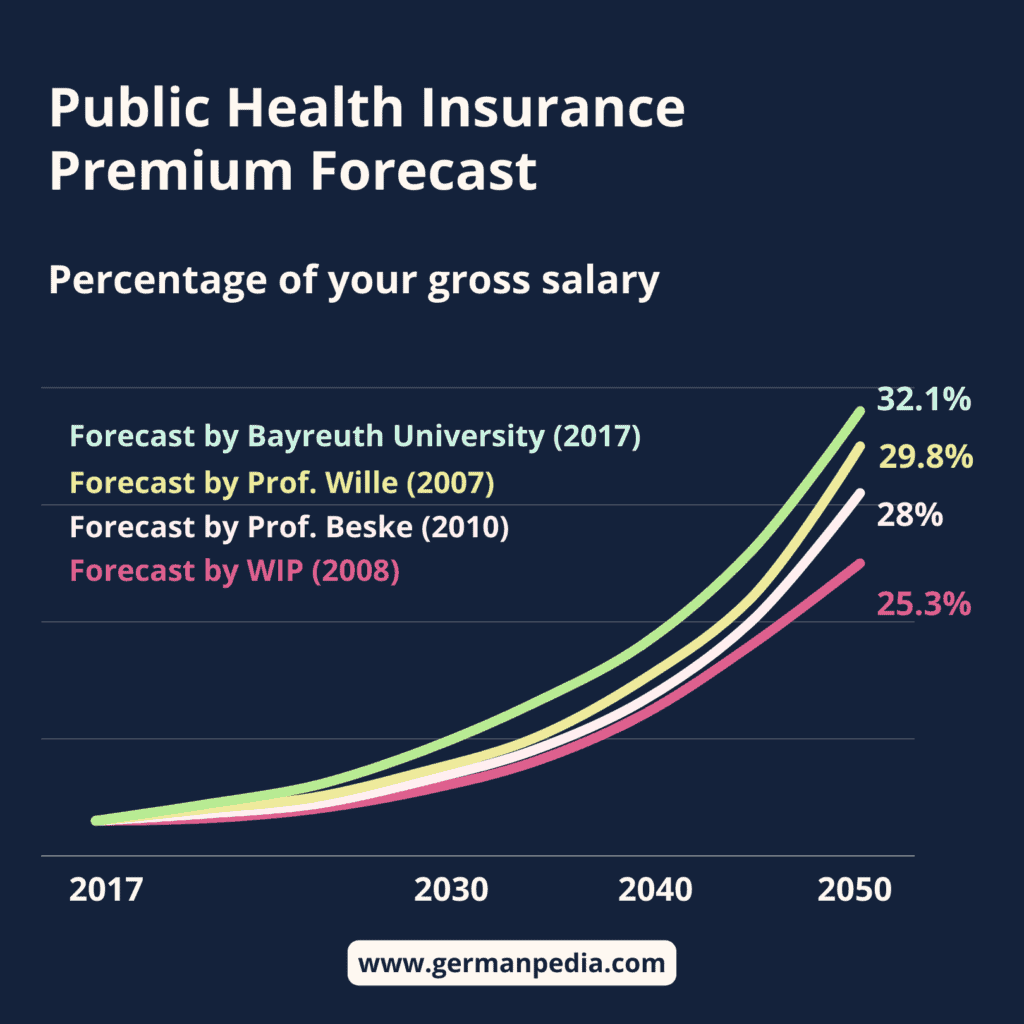
Table of Contents
Top public health insurance companies in Germany
| Public Health Insurance Company | Total Insured (Versichert) | Family members insured for free | Paying members (Mitglieder) | Insured for free (%) | As of |
|---|---|---|---|---|---|
| Techniker Krankenkasse (TK) | 11,804,078 | 2,638,412 | 9,165,666 | 22.35% | 1.1.2025 |
| BARMER | 8,683,320 | 1,557,950 | 7,125,370 | 17.94% | 1.1.2024 |
| DAK Gesundheit | 5,528,159 | 992,078 | 4,536,081 | 17.94% | 1.1.2024 |
| AOK Bayern | 4,659,900 | 1,009,251 | 3,650,685 | 21.65% | 27.12.2024 |
| AOK Baden-Württemberg | 4,552,637 | 1,079,185 | 3,473,452 | 23.7% | 1.1.2023 |
| AOK PLUS | 3,491,693 | 723,827 | 2,767,866 | 20.73% | 1.1.2025 |
| AOK Niedersachsen | 3,031,925 | 730,473 | 2,301,452 | 24.09% | 1.1.2024 |
| IKK classic | 3,021,574 | 601,574 | 2,420,000 | 19.9% | 1.1.2025 |
| AOK Rheinland/Hamburg | 3,021,798 | 769,169 | 2,252,633 | 25.45% | 1.1.2024 |
| AOK Nordwest | 2,954,414 | 736,520 | 2,217,894 | 24.92% | 1.1.2024 |
Source: Annual financial statements of insurance companies
Techniker Krankenkasse (TK) is Germany’s biggest public health insurance provider based on the number of insured members. TK has 11.8 million members as of 2025.
Barmer is the second largest public health insurance company after TK, with 8.68 million members.
AOK is a group of independent regional health insurance companies. When you combine all the AOK regional health insurance providers, AOK has 27 million insured members in Germany, which is almost one-third of the German population.
DAK Gesundheit and Barmer have the lowest percentage (17.9%) of members insured for free in family insurance. On the other hand, AOK Rheinland/Hamburg has the highest percentage (25.45%) of members insured for free in family insurance.
On average, 22% of the total insured members are insured for free in public family insurance. The higher the number of members insured for free, the higher the cost burden on the paying members.
TK is the cheapest public health insurer among the top ten biggest public health insurance companies. You can save up to 1000€ annually by switching to TK without compromising on the services.
We find TK the best public health insurance provider for expats. It offers its website, mobile app, and customer support in English.
You can register with TK online for free in 2 minutes using our “TK registration service.“
Register with TK

- Biggest public health insurance company in Germany based on number of members.
- Enjoy low premiums
- Get English customer support, website, and mobile app.
- Complete the application process in English.
How confident are Germans in their health insurance policy?
As per the survey of Rober Bosch Stiftung, 60% of the Germans have lost confidence in the German healthcare system. Three years ago, it was only 30% of the people.
It’s a big and justified drop. The German healthcare system is struggling due to increased expenses and reduced income.
The healthcare expenditure was 497.7 billion euros in 2022 and is increasing consistently each year.
The factors contributing to the rising healthcare expenditure are
- Germany’s aging population. More old people (60 and above) mean more medical expenses. 31% of the German population is 60 or above as of 2024. The situation will worsen as one-third of the German population will be 60 or above by 2050. [4]

- Inflation is increasing the cost of medical treatments, medicines, etc.
- Medical science progress: Innovations in the medical field offer patients better and more treatment options. This leads to increased medical spending.
- Longer life expectancy: Life expectancy in Germany is around 81 years [5]. Statistically, each year costs the health system about twice as much as the previous one.
To cover these healthcare costs, Germany needs more young earners to contribute to the public healthcare system. However, the population of young professionals is decreasing.
All these factors make people lose their trust in the German healthcare system. People fear that the German public healthcare system will no longer be able to offer high-quality service at an affordable price.
Moreover, experts predict that health insurance premiums will increase drastically in the future.

Why are Germans leaving public health insurance?
The number of high-earners switching to private health insurance in Germany has been increasing consistently for the past 10 years. There are three main reasons for people moving to a private healthcare system.
- People in public health insurance fear that their policy will no longer be able to offer good coverage at an affordable price in the near future.
- Private health insurance is cheaper than public health insurance for high-earners
- Private health insurance plans offer better medical coverage than public.
Moreover, private health insurance is better prepared for the future with 344 billion euros as of 19 Feb 2025 in aging reserves. On the other hand, the public health system has no aging reserve.
In our comparison and test, we found Allianz, LVM, and Signal Iduna private health insurance companies among the best.
Private health insurance is a complicated product. So, we recommend consulting a fee-based advisor or an insurance broker for personalized advice.
Book a free call with a health insurance expert

- German health insurance is a complicated product. There are several factors that must be considered before deciding which health insurance is best for you. An expert can guide you and help you pick the best option for you.
- An Insurance broker is liable for their advice. This means if the policy they recommended doesn’t offer the coverage you requested, they are liable to pay the damages incurred in the future.
How many people have public health insurance in Germany?
By Feb 2025, around 74.3 million were insured in statutory health insurance, which is around 90% of the German population [Source: Bundesministerium für Gesundheit].
- Total number of members paying contributions: 58.4 million
- Total number of members insured free of charge through family insurance: 15.9 million
We find TK the best public health insurance provider for expats. It offers its website, mobile app, and customer support in English.
You can register with TK online for free in 2 minutes using our “TK registration service.“
Register with TK

- Biggest public health insurance company in Germany based on number of members.
- Enjoy low premiums
- Get English customer support, website, and mobile app.
- Complete the application process in English.
How many people have private health insurance in Germany?
By the end of 2023, 38.26 million people in Germany had full or supplementary private health insurance, an increase of 0.43 million from the previous year (2022).
- Total number of people who have full private health insurance: 8.7 million
- Total number of people who have supplementary private health insurance: 29.6 million
- Total number of people insured in private health insurance: 38.26 million
More topics
- Best public health insurance in Germany
- Is private health insurance worth it?
- Private health insurance benefits that you don’t get public health insurance
- Minimum coverage your private health insurance plan should offer
- Private health insurance costs in Germany
- Private vs public health insurance
- Private health insurance cost in old age
- Why is private health insurance cheaper than public?
- How do you choose private health insurance deductible?
- German healthcare expenditure
- Private health insurance for self-employed in Germany
- Private health insurance for the unemployed in Germany
- Private health insurance for students in Germany
- Private health insurance for children in Germany
- Family health insurance in Germany
References
- https://www.tk.de/resource/blob/2150268/f5440f15294c210344ecc6b3bf04238d/tk-in-zahlen-1–quartal-2024-pdf-data.pdf
- https://www.barmer.de/ueberuns/barmer/geschaeftsberichte-bilanzen/jahresergebnis-2023-1056708
- https://geschaeftsbericht.tk.de/2023/zahlen-und-fakten/mitglieder-und-versichertenentwicklung/
- https://www.dak.de/dak/unternehmen/ueber-uns_12010#rtf-anchor-geschaftsberichte-der-dak-gesundheit
- https://www.aok.de/fk/plus/kontakt/geschaeftsbericht-2022-2023/
- https://www.aok.de/pp/bw/unternehmensbericht/
- https://www.ikk-classic.de/unternehmen/zahlen-fakten
- https://www.aok.de/pk/magazin/cms/fileadmin/pk/plus/pdf/strukturdaten-langversion-aokplus.pdf
